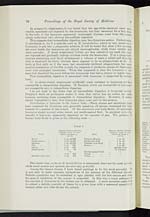Alexander Fleming (1881-1955)
Lysozyme: President's address
76
Proceedings of the Royal Society of Medicine
6
In phagocytic experiments it was found that the egg-white-resistant cocci were
readily opsonized and ingested by the leucocytes, but they remained for a long time
in the body of the leucocyte apparently unchanged, whereas cocci from the parent
strain underwent very obvious intracellular digestion.
This suggests that intracellular digestion may be a lysozyme action. Undoubtedly
it sometimes is, for if a microbe such as M. lysodeikticus, which is very sensitive to
lysozyme, is put into a phagocytic mixture, it will be found that after a few minutes
the cocci inside the leucocytes are almost unrecognizable, while those outside still
stain normally. If fæcal streptococci (which are less sensitive) are used, the cocci
are ingested and gradually undergo solution inside the leucocytes. If to a phagocytic
mixture containing such fæcal streptococci a volume of tears is added and then the
tube is incubated for thirty minutes there appears to be no phagocytosis at all. It
looks at first sight as if the tears had completely inhibited phagocytosis, but more
careful examination of the film reveals the presence of glutinous masses of degenerate
cocci with entangled leucocytes. What has happened is that the lysozyme of the
tears had dissolved the cocci before the leucocytes had had a chance to ingest them.
That intracellular digestion is associated with lysozyme is supported by certain
facts.
(1) As above stated, streptococci artificially made resistant to lysozyme are less
susceptible to intracellular digestion. (2) Bacteria which are susceptible to lysozyme
are susceptible also to intracellular digestion.
I do not want to lay down that all intracellular digestion is lysozyme action.
Douglas’s work on protrypsin makes it clear that serum has an action on some
bacteria, rendering them susceptible to intracellular digestion. However, it seems
almost impossible to deny that lysozyme plays some part in the process.
Distribution of lysozyme in the human body.—Many tissues and secretions have
been examined for lysozyme and, generally speaking, all tissues contained the lytic
ferment to a greater or less extent. Of the secretions and body-fluids, all contained
lysozyme except normal urine, sweat, and cerebrospinal fluid. In purulent urine the
amount of lysozyme apparently depended on the amount of pus. The potency of
human body-fluids is given in the following table :—
| TABLE I. | |||
| Highest dilution showing | Highest dilution showing | ||
| complete lysis of test | complete lysis of test | ||
| Fluid | coccus in 1 hour at | Fluid | coccus in 1 hour at |
| 45° C. | 45° C. | ||
| Tears ... ... ... | 1 in 40,000 | Pleural effusion ... | 1 in 81 |
| Nasal mucus ... ... | 1 in 13,500 | Hydrocele fluid ... | 1 in 50 |
| Sputum ... ... | 1 in 13,500 | Ovarian cyst fluid ... | 1 in 10 |
| Pus ... ... ... | 1 in 700 | Semen ... ... ... | 1 in 20 |
| Saliva ... ... ... | 1 in 300 | (partial lysis | |
| Blood serum ... ... | 1 in 40 | in 3 hours) | |
| to | Cerebrospinal fluid ... | — | |
| 1 in 270 | Sweat ... ... ... | — | |
| Parotid cyst fluid ... | 1 in 100 | Urine ... ... ... | — |
This shows that, so far as M. lysodeikticus is concerned, tears are the most potent,
while nasal mucus and sputum are also very powerful.
Among the human tissues I have found cartilage to be the most powerful. It
is not easy to make accurate estimations of the potency of the different tissues.
Definite quantities may be embedded in agar planted with the test coccus and then
the area of inhibition of the coccus is measured. In this way a rough estimate of
the amount of lysozyme in the tissues can be obtained. A more accurate method is
to extract a definite quantity of tissue for a given time with a measured quantity of
normal saline and then titrate the extract.


